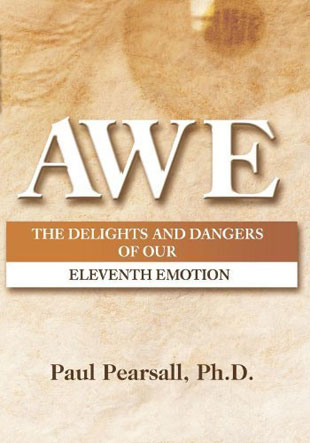Paul Pearsall (1942-2007) was a board-certified clinical neuropsychologist and clinical professor at the University of Hawaii; he sat on the board of directors for the State of Hawaii Consortium for Integrative Medicine. He was one of the first to explore and study what he called "the delights and dangers of our eleventh emotion."
In this pioneering examination of awe, Pearsall identifies it as the antidote to the widespread negative emotional state of languishing where one is neither sad or happy. A state of quiet despair is often a symptom of being "awe deficient." According to the author, awe is our most connective emotion and the more we think about ourselves the less likely we will get caught up in the pursuit of it. Pearsall writes:
"Awe is an emotion designed to help us experience and learn from the paradox that life is as dreadful as it is divine, better than we can imagine and worse than we fear, and as short as it is magnificent."
We have all experienced moments of awe as powerful and transformative moments when we have goose-bumps, our spines tingle, our eyes fill with tears, our hearts ache, and we feel like our breath has been taken away. This emotion brings us to a deeper respect for the mysteries of human nature, the natural world, and Creator of this splendid universe. Or as Pearsall puts it: "Awe is an overwhelming and bewildering sense of connection with a startling universe that is usually far beyond the narrow band of our consciousness."
Pearsall does his best to probe all sides of awe and comes up with eight common characteristics contained in almost every report of awe. In addition, he presents 14 questions designed to get at the heart of the nature of awe. This spiritual quality, according to the author, doesn't seem to be necessary for people who live in arrogant certainty or in constant pursuit of an unattainable happiness. But to those who are alert, awe's vastness can stir our souls in the rumblings of an earthquake, in the sound of a booming symphony, or in the leap of a whale out of the water in front of us. But it can also come to us in the small and tender surprises and epiphanies of everyday life as the sun streams through the window and creates a beautiful pattern on the shiny floor. We believe it is an essential element of a deep and rich spiritual life.
Pearsall quotes the Oxford English Dictionary where the word awe is defined as "an attitude of a mind subdued to profound reverence." Just to emphasize once again this emotion's eclecticism, the author shares 12 characteristics of the awe response including a gut feeling, a sense of being uplifted, an excited calm, the third tear, and breathlessness.
In the closing chapters, Pearsall emphasizes the awe-inspired state of flourishing; the close connections between awe, gratitude, compassion, contentment, joy, love, and zeal; and the shadow sides of awe in celebrity worship, competition, violence, and fear. We have the choice what to make and do with our awe. Pearsall suggests that every day we be on the constant lookout for people, places, things, and ideas that inspire awe. This truly is a path to transformation!
